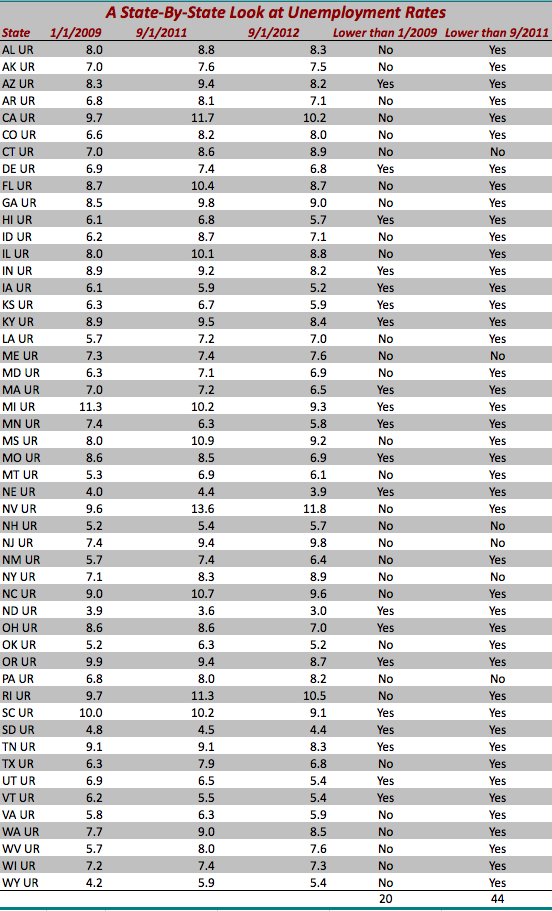@TBPInvictus:
Ever since the Reagan-Carter debate, the question asked of all voters continues to be: “Are you better off now than you were four years ago?”
Recall the circumstances of what was going on 4 years ago: A freefall caused by frozen credit markets, and a stock market mid-crash. Perhaps the better question — and what polling indicates Americans care about — refers to the more recent trend of the economy. We can explore that in many ways, via employment, income, inflation, etc.
For our purposes — and with all due respect to Jack Welch — let’s have a look at state-by-state Unemployment Rates.
We saw the final Regional & State Unemployment Report from BLS last week that we’ll get to see before November 6 elections. As noted in the report:
“Forty-one states and the District of Columbia recorded unemployment rate decreases, six states posted rate increases, and three states had no change, the U.S. Bureau of Labor Statistics reported today. Forty-four states and the District of Columbia registered unemployment rate decreases from a year earlier, while six states experienced increases. The national jobless rate decreased to 7.8 percent from August and was 1.2 percentage points lower than in September 2011.”
Let’s take a look at how state-by-state unemployment has fared on both fronts:
(Notes on table: Source: FRED (via the fabulous Excel Add-in). First two letters are state abbreviations, “UR” is FRED-speak for Unemployment Rate. Also please note that state rates are not translatable into the national rate.)
Where is the unemployment rate higher than where it stood one year ago? Six states, all in the northeast or mid-atlantic region: Connecticut, Maine, New Hampshire, New Jersey, New York, Pennsylvania. The rates in these six states are also higher – in some cases significantly so – than they were four years ago. (Adding: In NY, CT, NJ, for sure, this has much to do with the ongoing and savage slimming down of the finance industry.)
The Swing States
As to the swing states (does anything else really matter?), let’s filter out the noise (i.e. the solidly blue and red states) and look at them on a stand-alone basis (see also here for a swing-state map):
In this view, only one of nine – New Hampshire (4 electoral votes) – is higher now than it was one year ago, while eight have seen an improving year-over-year trend. Critically, Ohio (18 electoral votes) has seen a significant improvement from 8.6 down to 7.0 on both a year-over-year and inauguration-to-date basis. The only other state with a rate lower than January 2009 is Iowa (6 electoral votes), which has dropped from 6.1 to 5.2; the other seven are still higher than they were four years ago.
The extent to which this data will influence voters will clearly hinge on whether they’re employed or unemployed. I also believe that real income, a direct consequence of gaping labor market slack, is problematic for the incumbent office holder. But, for whatever it’s worth, the trend in statewide unemployment rates does seem to be a tailwind, with one more national number due the Friday before election day.
The challenger asks “Are you better off now than you were four years ago?” The incumbent has been rephrasing the question to ask “Are you better off now than you were last year?” If you can discern which answer voters think is more important, then you can likely figure out what the outcome of the Presidential election will be.




What's been said:
Discussions found on the web: